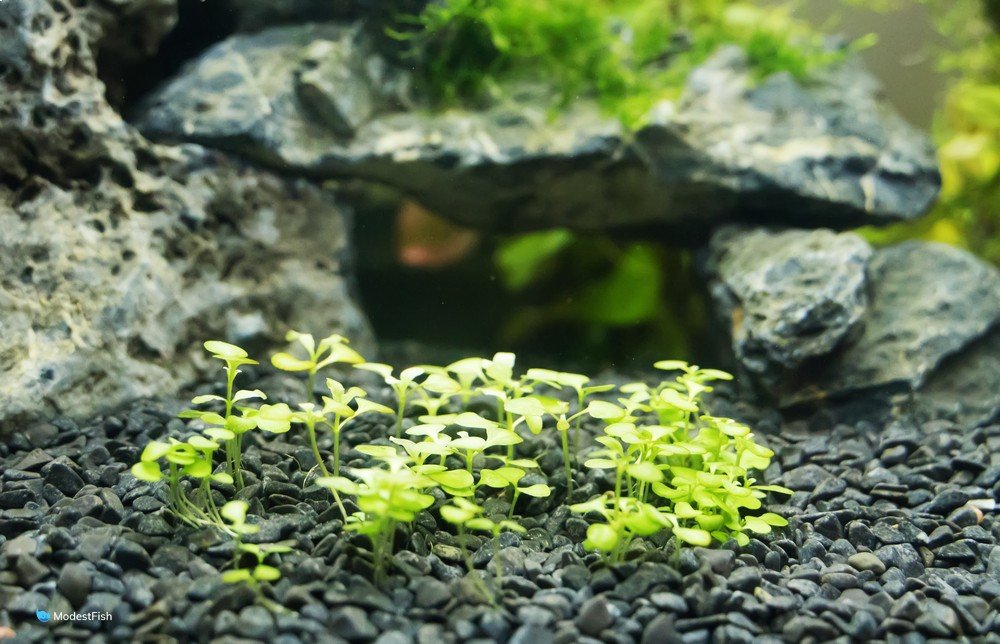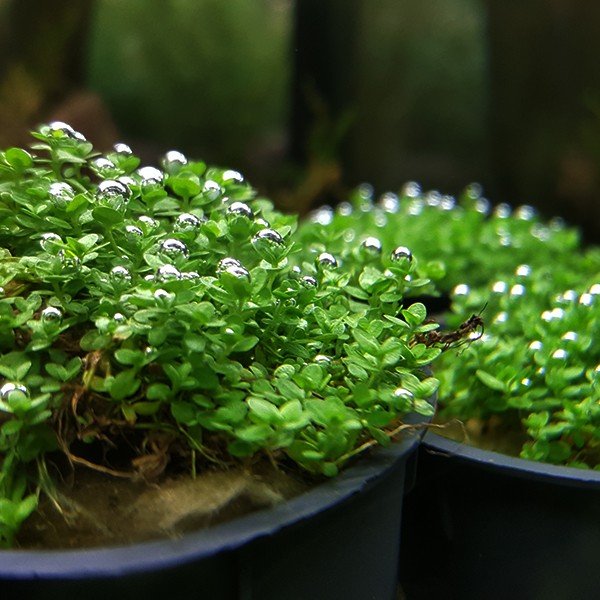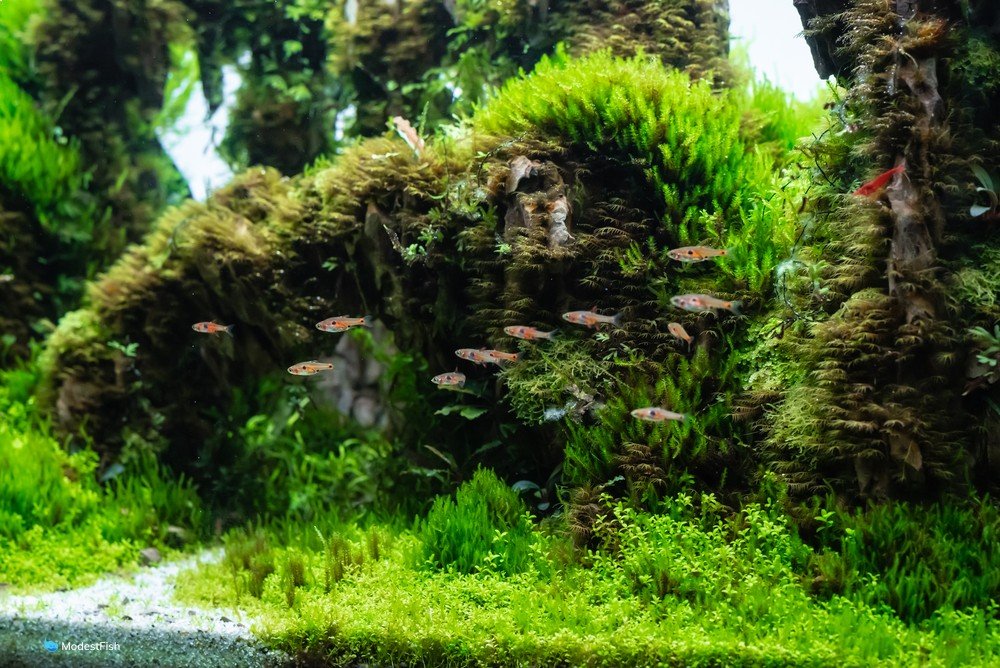Dwarf baby tears (Hemianthus callitrichoides) are vibrant, lush green, carpeting plants popularly used to create thick foregrounds in aquariums.
They require effort and attention. If you don’t provide high lighting, co2 injection, nutrient-rich substrate, and high quality fertilizers, you’re not going to have a good time.
If you’re willing to provide these, this guide will teach you how to plant and care for dwarf baby tears in your tank.
Quick Care Stats:
- Scientific Name: Hemianthus Callitrichoides
- Family: Scrophulariaceae
- Order: Lamiales
- Genus: Hemianthus
- Care Level: High – requires high light, CO2, nutrient rich substrate
- Growth Rate: Slow
- Maximum Size: 1.2 inches vertically and 4 inches horizontally
- Water Conditions: Soft, neutral water at room temperature
- Lighting: Medium to high lighting levels (PAR 50-80)
- Tank Placement: Foreground or free-floating
Table of Contents
Dwarf Baby Tears (Hemianthus callitrichoides) Overview

This lush green plant has some fascinating scientific facts; read on to explore more about them.
Rocky rivers and streams in Cuba, Puerto Rico, and Jamaica are the original habitats of Dwarf Baby Tears or Hemianthus Callitrichoides. Thankfully, they’ve adapted to life in captivity, so many aquariums can reap the advantages of growing them.
They’re one of the tiniest aquarium plants, growing to about 1.2 inches, with exceptional bright green coloring combined with a soft creamy color of their roots.
The leaves of the plant are only about a millimeter and are oval-round shaped. They also feature long spindly roots that help propagate the carpeting foreground for tanks, as the roots stay anchored in the substrate, absorbing essential nutrients.
But what I love most about using this plant is its unique feature of producing tiny bubbles of oxygen that resemble pearls that sit on top of the plant. I think it’s magical

Aquarium Care Requirements
The below care guidelines ensure that you select the suitable methods for looking after your plant, allowing it to blossom with health and longevity.
Tank Size
There is no max or minimum tank size for dwarf baby tears. The plant will only grow a few inches high.
Water Parameters
The water parameters below are guidelines for what conditions the Dwarf Baby Tears enjoy.
- Temperature: Maintain a temperature between the ranges of 68 – 75° F in your tank. This small plant tends to be sensitive to temperature, so you mustn’t overlook this factor.
- pH: Dwarf Baby Tears plant enjoys a pH level between 6.0 – 7.5.
- kH: Secure the water hardness to be between 1 – 10 dGH.
- Hardness: This plant enjoys relatively soft water.
Lighting
Dwarf Baby Tears are photophilic, which means they can’t sustain growth in dark lighting. Thus you’ll need to provide medium to high lighting (PAR 50-80), 10-12 hours daily, for this plant to grow healthily.
I find using a customizable LED light for planted tanks the best way to do this. In my experience, being able to control the brightness and have my light on a timer is the easiest way to grow aquarium plants.
For dwarf baby tears, a powerful light like the Fluval Planted 3.0 might be your best option.
Substrate and Fertilizers
Dwarf Baby Tears have a weak root anchorage and can take time to root well into the substrate. Use a porous, small-grained, lightweight substrates as these work better for plants with weak rooting systems.
Opt for nutrient-rich soils such as the Amazonia Aqua Soil or powder. These two have refined grains that help the plant’s roots anchor quickly, enabling faster growth and substrate anchorage. You can use fine sand, but you must use root tabs to have any chance.
Dwarf Baby Tears require CO2 injection to maintain healthy growth. It isn’t easy to grow thick carpets and sustain them for long durations of time without using some fertilizer and CO2. You will require about 10-3 mg/l of CO2 and some iron supplements every time you notice the stems of the plant pointing upwards or the leaves turning smaller.
You can use fertilizers like Flourish Excel to speed up growth and supplement with some iron if the plant leaves and shoots start turning yellow.
Maintenance & Trimming
Maintenance and trimming dwarf baby tears is arduous and you must be consistent. Whenever I’ve been lazy in the past, the lower leaves quickly die off and it starts to uproot itself from the trapped substrate. This happens because new leaves grow over the tops of old ones and block their light. Regular timing is a must.
If you see bubbles trapped under the carpet, giving it a gentle push down to flatten will help release them. I find using the wave S-shaped aquascaping scissors to cut carpeting plants like dwarf baby tears the easiest method.
How to Plant Dwarf Baby Tears
Once you have your dwarf baby tears and remove it from its packaging, you want to separate it into multiple bunches (sometimes these are referred to as plugs). You need to be careful not to tear the roots during this process.
You have a couple of options to plant. Firstly, you separate it into small bunches and plant into the substrate where you desire. Grab the base of the plant, just above the roots and gently push it into the substrate either with your hands or tweezers.
Or, another way I have had success in the past is using fishing line to tie it to some hardscape, like a rock or a piece of driftwood and setting it down just on the substrate.
It’ll take some time, but once they get adjusted, the plant will slowly start covering your substrate and filing in.
Dwarf baby tears are actually a floating plant naturally. So be extra careful when filling up your tank after planting. Any disruption of the substrate will cause them to float up.
How to Propagate Dwarf Baby Tears
Dwarf baby tears will release shoots, propagate, and spread out all by itself. But, if you want to pull some out to replant elsewhere in your tank or in another tank, you just need to put your scissors into the substrate and cut out a small bunch. As long as the roots look good, you can just replant wherever you like.
Tank Mates for Dwarf Baby Tears
Dwarf Baby Tears require high-intensity lighting, so pair them with plants such as Rotala Macrandra, Christmas Moss, and Eleocharis Montevidensis that also require this.
Freshwater, peaceful fish such as Cichlids and Tetras would be perfect tank mates for Dwarf Baby Tears.
Larger, ravaging fish such as Oscars or Jack Dempseys may nip at the plant and damage its integrity.
How to Use Dwarf Baby Tears in Aquarium

These beautiful plants grow in bright clusters that you can use to aquascape your tank to create a lush carpeted effect. You can even allow them to float freely at the top of your tank, blocking some light for tank mates that may prefer subdued conditions for hideouts and breeding.
You can use Dwarf Baby Tears to create a natural aquatic environment by growing them on driftwood and other natural porous materials, giving your aquarium a unique aquascape.
How to Choose Healthy Dwarf Baby Tears
Look out for bright green shoots, no rips on the leaves, and many creamy-white roots.
Are Dwarf Baby Tears Right For You?
If you’re a complete beginner, I don’t recommend you go with dwarf baby tears. It can be finicky and troublesome. But, if you’re willing to put the work in, this plant can look fantastic.
If you’re more experienced, looking to dip your toe into high-lighting and CO2 injection, dwarf baby tears can be a great challenge and a very rewarding one when successful.
You just must keep on top of trimming.
